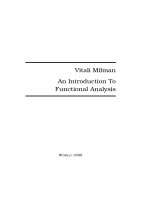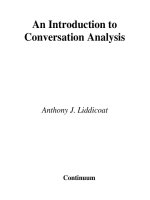An introduction to survival analysis using stata
Bạn đang xem bản rút gọn của tài liệu. Xem và tải ngay bản đầy đủ của tài liệu tại đây (13.79 MB, 441 trang )
An Introduction to Survival Analysis
Using Stata
Third Edition
MARIO CLEVES
Department of Pediatrics
University of Arkansas Medical Sciences
WILLIAM GOULD
Stat a Corp
ROBERTO G. GUTIERREZ
StataCorp
YULIA V. MARCHENKO
StataCorp
A Stata Press Publication
StataCorp LP
College Station, Texas
Copyright © 2002, 2004, 2008, 2010 by StataCorp LP
All rights reserved. First edition 2002
Revised edition 2004
Second edition 2008
Third edition 2010
Published by Stata Press, 4905 Lakeway Drive, College Station, Texas 77845
Typeset in I5\'lEX 2g
Printed in the United States of America
10 9 8 7 6 5 4 3 2 1
ISBN-10: 1-59718-074-2
ISBN-13 : 978-1-59718-074-0
No part of this book may be reproduced, stored in a retrieval system, or transcribed , in any
form or by any means- electronic, mechanical, photocopy, recording, or otherwise-without
the prior written permission of StataCorp LP.
Stata is a registered trademark of StataCorp LP.
Mathematical Society.
I5\'lEX 2g
is a trademark of the American
Contents
List of Tables
List of Figures
xix
Preface to the Second Edition
xxi
Preface to the First Edition
Notation and Typography
2
xxiii
XXV
xxvii
The problem of survival analysis
1
1.1
Parametric modeling . . .
2
1.2
Semiparametric modeling
3
1.3
Nonparametric analysis
5
1.4
Linking the three approaches
5
Describing the distribution of failure times
7
2.1
The survivor and hazard functions
7
2.2
The quantile function . . . . . . . .
10
2.3
Interpreting the cumulative hazard and hazard rate .
13
2.3.1
Interpreting the cumulative hazard
13
2.3.2
Interpreting the hazard rate
15
2.4
3
XV
Preface to the Third Edition
Preface to the Revised Edition
1
xiii
Means and medians .
16
Hazard models
19
3.1
Parametric models
20
3.2
Semiparametric models .
21
3.3
Analysis time (time at risk)
24
Contents
Vl
4
Censoring and truncation
29
401
Censoring 0 0 0 0 0 0 0 0
29
40101
Right-censoring
30
401.2
Interval-censoring
32
401.3
Left-censoring
34
402
5
6
7
Truncation 0 0 0 0 0 0 0
34
40201
Left-truncation (delayed entry)
34
40202
Interval-truncation (gaps)
35
40203
Right-truncation
36
Recording survival data
37
501
The desired format
37
502
Other formats 0 0 0
40
503
Example: Wide-form snapshot data 0
44
Using stset
47
601
A short lesson on dates 0
48
602
Purposes of the stset command
51
603
Syntax of the stset command 0
51
60301
Specifying analysis time
52
60302
Variables defined by stset
55
60303
Specifying what constitutes failure
57
603.4
Specifying when subjects exit from the analysis
59
60305
Specifying when subjects enter the analysis
62
60306
Specifying the subject-ID variable
65
60307
Specifying the begin-of-span variable
60308
Convenience options
0
0
000000000
67
70
After stset
73
701
Look at stset's output
73
702
List some of your data
76
703
Use stdescribe 0
77
704
Use stvary 0 0 0
78
Contents
8
9
Vll
7.5
Perhaps use stfill . . . . . .
80
7.6
Example: Hip fracture data
82
Nonparametric analysis
91
8.1
Inadequacies of standard univariate methods
91
8.2
The Kaplan-Meier estimator
93
8.2.1
Calculation
93
8.2.2
Censoring .
96
8.2.3
Left-truncation (delayed entry)
97
8.2.4
Interval-truncation (gaps)
99
8.2.5
Relationship to the empirical distribution function
8.2.6
Other uses of sts list . . . . . . . . .
101
8.2.7
Graphing the Kaplan-Meier estimate
102
. . .
99
8.3
The Nelson-Aalen estimator ..
107
8.4
Estimating the hazard function
113
8.5
Estimating mean and median survival times
117
8.6
Tests of hypothesis . . . .
122
8.6.1
The log-rank test
123
8.6.2
The Wilcoxon test
125
8.6.3
Other tests
125
8.6.4
Stratified tests .
126
The Cox proportional hazards model
129
9.1
130
Using stcox . . . . . . . . . . . . . .
9.1.1
The Cox model has no intercept .
131
9.1.2
Interpreting coefficients . . . . . .
131
9.1.3
The effect of units on coefficients
133
9.1.4
Estimating the baseline cumulative hazard and survivor
functions . . . . . . . . . . . . . . . . . .
135
9.1.5
Estimating the baseline hazard function
139
9.1.6
The effect of units on the baseline functions
143
Contents
viii
9.2
Likelihood calculations .
145
9.2.1
No tied failures
145
9.2.2
Tied failures ..
148
The marginal calculation .
148
The partial calculation ..
149
The Breslow approximation
150
The Efron approximation
151
Summary
151
9.2.3
9.3
9.4
9.5
9.6
10
Stratified analysis .
152
9.3.1
Obtaining coefficient estimates
152
9.3.2
Obtaining estimates of baseline functions .
155
Cox models with shared frailty
156
9.4.1
Parameter estimation .
157
9.4.2
Obtaining estimates of baseline functions .
161
Cox models with survey data
•
0
• • • •
164
9.5.1
Declaring survey characteristics
165
9.5.2
Fitting a Cox model with survey data
166
9.5.3
Some caveats of analyzing survival data from complex
survey designs . . . . . . . . . . . . . . . . .
168
Cox model with missing data-multiple imputation .
169
9.6.1
Imputing missing values ...
171
9.6.2
Multiple-imputation inference
173
Model building using stcox
177
10.1
Indicator variables
177
10.2
Categorical variables
178
10.3
Continuous variables
180
10.3.1
182
Fractional polynomials
10.4 Interactions
10.5
0
•
0
••
0
186
Time-varying variables
189
10.5.1
191
Using stcox, tvc() texp()
Contents
ix
10.5.2
10.6
11
Using stsplit . .
193
Modeling group effects: fixed-effects, random-effects, stratification, and clustering . . . . . . . . . . . . . . . . . . . . . . . . .
The Cox model: Diagnostics
203
11.1
Testing the proportional-hazards assumption
203
11.1.1
Tests based on reestimation . . . .
203
11.1.2
Test based on Schoenfeld residuals
206
11.1.3
Graphical methods . . . .
209
11.2
Residuals and diagnostic measures
Reye's syndrome data
12
13
197
. .
212
213
11.2.1
Determining functional form .
214
11.2.2
Goodness of fit
....... .
219
11.2.3
Outliers and influential points
223
Parametric models
229
12.1
Motivation . . .
229
12.2
Classes of parametric models
232
12.2.1
Parametric proportional hazards models
233
12.2.2
Accelerated failure-time models . . . .
239
12.2.3
Comparing the two parameterizations
241
A survey of parametric regression models in Stata
245
13.1
The exponential model . . . . . . . . . . . . . . .
247
13.1.1
Exponential regression in the PH metric
247
13.1.2
Exponential regression in the AFT metric
254
13.2
. . . . . . . . . . . . . . .
256
Weibull regression in the PH metric .
256
Fitting null models . . . . . . . . . .
261
Weibull regression in the AFT metric .
265
Weibull regression
13.2.1
13.2.2
13.3
Gompertz regression (PH metric) . .
266
13.4
Lognormal regression (AFT metric) .
269
13.5
Loglogistic regression (AFT metric) .
273
Contents
X
14
13.6
Generalized gamma regression (AFT metric)
276
13.7
Choos1ng among parametric models .
278
13.7.1
Nested models . . .
278
13.7.2
Nonnested models.
281
Postestimation commands for parametric models
283
14.1
Use of predict after streg . . . . . . . .
283
14.1.1
Predicting the time of failure
285
14.1.2
Predicting the hazard and related functions
291
14.1.3
Calculating residuals
294
Using stcurve . . . . . . . . .
295
14.2
15
16
Generalizing the parametric regression model
301
15.1
Using the ancillary() option
301
15.2
Stratified models
307
15.3
Frailty models ..
310
15.3.1
Unshared frailty models
311
15.3.2
Example: Kidney data .
312
15.3.3
Testing for heterogeneity
317
15.3.4
Shared frailty models . .
324
Power and sample-size determination for survival analysis
333
16.1
Estimating sample size . . . . . .
335
16.1.1
Multiple-myeloma data .
336
16.1.2
Comparing two survivor functions nonparametrically
337
16.1.3
Comparing two exponential survivor functions .
341
16.1.4
Cox regression models . . . . . . . . . . .
345
16.2
Accounting for withdrawal and accrual of subjects
348
16.2.1
The effect of withdrawal or loss to follow-up
348
16.2.2
The effect of accrual
349
16.2.3
Examples . . . . . .
351
16.3
Estimating power and effect size
359
16.4
Tabulating or graphing results ..
360
Contents
17
Xl
Competing risks
365
17.1
Cause-specific hazards
366
17.2
Cumulative incidence functions
367
17.3
Nonparametric analysis
17.4
..
368
17.3.1
Breast cancer data
369
17.3.2
Cause-specific hazards
369
17.3.3
Cumulative incidence functions
372
Semiparametric analysis . . . .
375
17.4.1
Cause-specific hazards
375
Simultaneous regressions for cause-specific hazards
378
Cumulative incidence functions
382
Using stcrreg
382
Using stcox
389
17.4.2
17.5
Parametric analysis .
389
References
393
Author index
401
Subject index
405
Tables
8.1
r x 2 contingency table for time tj
123
9.1
Methods for handling ties .....
151
9.2
Various models for hip-fracture data
154
13.1
streg models . . . . . . . . .
281
13.2
AIC values for streg models
282
14.1
Options for predict after streg
283
14.2
Use of predict, surv and predict, csurv
293
Figures
2.1
Hazard functions obtained from various parametric survival models
8.1
Kaplan-Meier estimate for hip-fracture data
. . . .
103
8.2
Kaplan-Meier estimates for treatment versus control
104
8.3
Kaplan-Meier estimate with the number of censored observations .
105
8.4
Kaplan-Meier estimates with a number-at-risk table . . . . . . .
106
8.5
Kaplan-Meier estimates with a customized number-at-risk table
107
8.6
Nelson-Aalen curves for treatment versus control . . . .
110
8.7
Estimated survivor functions. K-M = Kaplan-Meier; N-A =
Nelson-Aalen. . . . . . . . . . . . . . . . . . . . . . . . . . . . . . . 111
8.8
Estimated cumulative hazard functions. N-A = Nelson-Aalen;
K-M =Kaplan-Meier. . .
112
Smoothed hazard functions
114
8.9
10
8.10 Smoothed hazard functions with the modified epan2 kernel for
the left and right boundaries . . . . .
116
8.11 Smoothed hazard functions, log scale .
117
8.12 Exponentially extended Kaplan-Meier estimate .
121
8.13 Exponentially extended Kaplan-Meier estimate, treatment group .
122
9.1
Estimated baseline cumulative hazard . . . . . . . . . .
136
9.2
Estimated cumulative hazard: treatment versus controls
137
9.3
Estimated baseline survivor function . . . . . .
137
9.4
Estimated survivor: treatment versus controls .
138
9.5
Estimated baseline hazard function . . . . . . .
140
9.6
Estimated hazard functions: treatment versus control
141
9.7
Log likelihood for the Cox model . . . . . . . . . . . .
147
Figures
xvi
9.8
Estimated baseline cumulative hazard for males versus females
155
9.9
Comparison of survivor curves for various frailty values
163
164
9.10 Comparison of hazards for various frailty values
11.1
Test of the proportional-hazards assumption for age
209
11.2
Test of the proportional-hazards assumption for protect
210
11.3
Test of the proportional-hazards assumption for protect,
controlling for age . . . . . . . . . . . . . . . . . . . . . .
211
11.4
Comparison of Kaplan-Meier and Cox survivor functions
212
11.5
Finding the functional form for ammonia .
216
11.6
Using the log transformation . . . . . . .
216
11.7
Cumulative hazard of Cox-Snell residuals (ammonia)
221
11.8
Cumulative hazard of Cox-Snell residuals (lamm)
222
11.9
DFBETA(sgot) for Reye's syndrome data
224
..
11.10 DFBETA(ftliver) for Reye's syndrome data
225
11.11 Likelihood displacement values for Reye's syndrome data
226
11.12 LMAX values for Reye's syndrome data.
227
13.1
Estimated baseline hazard function . . .
250
13.2
Estimated baseline hazard function using ln(myt
13.3
Estimated batieline hazard function using a step function
252
13.4
Estimated baseline hazard function using a better step function .
253
13.5
Comparison of estimated baseline hazards
254
13.6
Weibull hazard function for various p
257
13.7
Estimated baseline hazard function for Weibull model
260
13.8
Comparison of exponential (step) and Weibull hazards .
261
13.9
Estimated Weibull hazard functions over values of protect
263
+ 1)
. .
251
13.10 Gompertz hazard functions . . . . . . . . . . . . . .
267
13.11 Estimated baseline hazard for the Gompertz model.
269
= 0)
270
13.13 Comparison of hazards for a lognormal model ..
272
13.12 Examples of lognormal hazard functions ((30
Figures
xvii
13.14 Examples of loglogistic hazard functions ((30 = 0) ..
274
14.1
Cumulative Cox-Snell residuals for a Weibull model
294
14.2
Hazard curves for the gamma model (protect==O)
297
14.3
Hazard curves for the gamma model (protect==1)
298
14.4
Cumulative survivor probability as calculated by predict
299
14.5
Survivor function as calculated by stcurve . . . . . .
300
15.1
Comparison of baseline hazards for males and females
308
15.2
Comparison of lognormal hazards for males and females
318
15.3
Comparison of Weibull/gamma population hazards . . .
323
15.4
Comparison of Wei bull/ gamma individual (aj = 1) hazards
324
15.5
Comparison of piecewise constant individual (a= 1) hazards
331
16.1
Kaplan-Meier and exponential survivor functions for multiplemyeloma data . . . . . . . . . . . . . . . . . . . . . . . . . . . . . . . 342
16.2
Accrual pattern of subjects entering a study over a period of 20
months . . . . . . . . . . . . . . . . . . . . . . .
354
16.3
Main tab of stpower exponential's dialog box .
356
16.4
Accrual/Follow-up tab of stpower exponential's dialog box
357
16.5
Column specification in stpower exponential's dialog. .
363
16.6
Power as a function of a hazard ratio for the log-rank test
364
17.1
Comparative cause-specific hazards for local relapse .
370
17.2
Comparative cause-specific hazards for distant relapse
372
17.3
Comparative cumulative incidence of local relapses
374
17.4
Comparative hazards for local relapse after stcox
377
17.5
Comparative hazards for distant relapse after stcox
378
17.6
Comparative CIFs for local relapse after stcrreg
385
17.7
Stacked cumulative incidence plots . . . . . . . .
388
17.8
Comparative hazards for local relapse after streg
390
Preface to the Third Edition
This third edition updates the second edition to reflect the additions to the softwan
made in Stata 11, which was released in July 2009. The updates include syntax anc
output changes. The two most notable differences here are Stata's new treatment o:
factor (categorical) variables and Stata's new syntax for obtaining predictions and othe1
diagnostics after st cox.
As of Stata 11, the xi : prefix for specifying categorical variables and interactiom
has been deprecated. Whereas in previous versions of Stata, you might have typed
. xi: stcox i.drug*i.race
to obtain main effects on drug and race and their interaction, in Stata 11 you type
. stcox i.drug##i.race
Furthermore, when you used xi: , Stata created indicator variables in your data thai
identified the levels of your categorical variables and interactions. As of Stata 11, thE
calculations are performed intrinsically without generating any additional variables in
your data.
Previous to Stata 11, if you wanted residuals or other diagnostic measures for Co:x
regression, you had to specify them when you fit your model. For example, to obtain
Schoenfeld residuals you might have typed
. stcox age protect, schoenfeld(sch*)
to generate variables sch1 and sch2 containing the Schoenfeld residuals for age and
protect, respectively. This has been changed in Stata 11 to be more consistent with
Stata's other estimation commands. The new syntax is
. stcox age protect
. predict sch*, schoenfeld
Chapter 4 has been updated to describe the subtle difference between right-censoring
and right-truncation, while previous editions had treated these concepts as synonymous.
Chapter 9 includes an added section on Cox regression that handles missing data
with multiple imputation. Stata 11 's new mi suite of commands for imputing missing
data and fitting Cox regression on multiply imputed data are described. mi is discussed
in the context of stcox, but what is covered there applies to streg and stcrreg (which
also is new to Stat a 11), as well.
XX
Preface to the Third Edition
Chapter 11 includes added discussion of three new diagnostic measures after Cox
regression. These measures are supported in Stata 11: DFBETA measures of influence,
LMAX values, and likelihood displacement values. In previous editions, DFBETAs were
discussed, but they required manual calculation.
Chapter 17 is new and describes methods for dealing with competing risks, where
competing failure events impede one's ability to observe the failure event of interest.
Discussion focuses around the estimation of cause-specific hazards and of cumulative
incidence functions. The new stcrreg command for fitting competing-risks regression
models is introduced.
College Station, Texas
July 2010
Mario A. Cleves
William W. Gould
Roberto G. Gutierrez
Yulia V. Marchenko
Preface to the Second Edition
This second edition updates the revised edition (revised to support Stata 8) to reflec
Stata 9, which was released in April2005, and Stata 10, which was released in June 2007
The updates include the syntax and output changes that took place in both versions. Fo
example, as of Stata 9 the est at phtest command replaces the old stphtest comman(
for computing tests and graphs for examining the validity of the proportional-hazard
assumption. As of Stata 10, all st commands (as well as other Stata commands) accep
option vee ( vcetype). The old robust and cluster ( varname) options are replaced wit]
vee (robust) and vee (cluster varname). Most output changes are cosmetic. Ther'
are slight differences in the results from streg, distribution(gamma), which has bee1
improved to increase speed and accuracy.
Chapter 8 includes a new section on nonparametric estimation of median and mea1
survival times. Other additions are examples of producing Kaplan-Meier curves wit]
at-risk tables and a short discussion of the use of boundary kernels for hazard functim
estimation.
Stata's facility to handle complex survey designs with survival models is describec
in chapter 9 in application to the Cox model, and what is described there may also b(
used with parametric survival models.
Chapter 10 is expanded to include more model-building strategies. The use of frac·
tional polynomials in modeling the log relative-hazard is demonstrated in chapter 10
Chapter 11 includes a description of how fractional polynomials can be used in deter
mining functional relationships, and it also includes an example of using concordancE
measures to evaluate the predictive accuracy of a Cox model.
Chapter 16 is new and introduces power analysis for survival data. It describe~
Stata's ability to estimate sample size, power, and effect size for the following surviva
methods: a two-sample comparison of survivor functions and a test of the effect of <
covariate from a Cox model. This chapter also demonstrates ways of obtaining tabula1
and graphical output of results.
College Station, Texas
March 2008
Mario A. Cleves
William W. Gould
Roberto G. Gutierrez
Yulia V. Marchenko
Preface to the Revised Edition
This revised edition updates the original text (written to support Stata 7) to reflect
Stata 8, which was released in January 2003. Most of the changes are minor and
include new graphics, including the appearance of the graphics and the syntax used to
create them, and updated datasets.
New sections describe Stata's ability to graph nonparametric and semiparametric
estimates of hazard functions. Stata now calculates estimated hazards as weighted
kernel-density estimates of the times at which failures occur, where weights are the
increments of the estimated cumulative hazard function. These new capabilities are
described for nonparametric estimation in chapter 8 and for Cox regression in chapter 9.
Another added section in chapter 9 discusses Stata's ability to apply shared frailty
to the Cox model. This section complements the discussion of parametric shared and
unshared frailty models in chapter 8. Because the concept of frailty is best understood
by beginning with a parametric model, this new section is relatively brief and focuses
only on practical issues of estimation and interpretation.
College Station, Texas
August 2003
Mario A. Cleves
William W. Gould
Roberto G. Gutierrez









